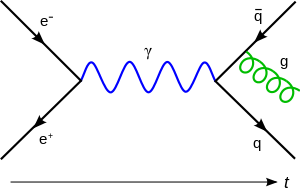Weyl equation
In physics, particularly quantum field theory, the Weyl equation is a relativistic wave equation for describing massless spin-1/2 particles called Weyl fermions. It is named after the German mathematician and mathematical physicist Hermann Weyl.
| Quantum field theory |
|---|
 |
| History |
|
Background
|
|
|
Scientists
|
Equation
The general equation can be written: [1][2][3]
explicitly in SI units:
where
is a vector whose components are the 2 × 2 identity matrix for μ = 0 and the Pauli matrices for μ = 1,2,3, and ψ is the wavefunction – one of the Weyl spinors.
Weyl spinors
The term "Weyl spinor" can refer to either one of two distinct but related objects. One refers to the plane-wave solutions of the Weyl equation, given here. The other refers to the abstract algebra of spinors, as geometric objects, at a single point in space-time (that is, abstract spinors in zero-dimensional space-time). These abstract spinors are defined and discussed in greater detail in the articles on the spin group and the Weyl–Brauer matrices. The algebra of zero-dimensional geometric spinors can be extended to four-dimensional spacetime (or to manifolds of other dimensions) by means of a spin structure. Very briefly, spin structures can be taken as fiber bundles, where the fiber is the geometric spinor, transforming under the action of the spin group. Solutions to the Weyl equation are then specific sections through the bundle.
These more formal considerations do not need to be understood to give the basic plane-wave solutions to the Weyl equation. These solutions are the left and right handed Weyl spinors, each with two components. Both have the form
- ,
where
is a constant two-component spinor which satisfies
- .
By direct manipulation, one obtains that
- ,
and concludes that the equations correspond to a particle that is massless. As a result, the magnitude of momentum p relates directly to the wave-vector k by the De Broglie relations as:
The equation can be written in terms of left and right handed spinors as:
where .
Helicity
The left and right components correspond to the helicity λ of the particles, the projection of angular momentum operator J onto the linear momentum p:
Here .
Derivation
The equations are obtained from the Lagrangian densities
By treating the spinor and its conjugate (denoted by ) as independent variables, the relevant Weyl equation is obtained.
See also
- Weyl semimetal
- Dirac equation (which describes massive spin-1/2 particles)
- Angular momentum operator
- Momentum operator
- Spin (physics)
References
- Quantum Mechanics, E. Abers, Pearson Ed., Addison Wesley, Prentice Hall Inc, 2004, ISBN 978-0-13-146100-0
- The Cambridge Handbook of Physics Formulas, G. Woan, Cambridge University Press, 2010, ISBN 978-0-521-57507-2.
- An Introduction to Quantum Field Theory, M.E. Peskin, D.V. Schroeder, Addison-Wesley, 1995, ISBN 0-201-50397-2
Further reading
- Quantum Field Theory Demystified, D. McMahon, McGraw-Hill (USA), 2008, ISBN 978-0-07-154382-8
- Particle Physics (2nd Edition), B.R. Martin, G. Shaw, Manchester Physics, John Wiley & Sons, 2008, ISBN 978-0-470-03294-7
- Supersymmetry Demystified, P. LaBelle, McGraw-Hill (USA), 2010, ISBN 978-0-07-163641-4
- The Road to Reality, Roger Penrose, Vintage books, 2007, ISBN 0-679-77631-1
- Johnston, Hamish (23 July 2015). "Weyl fermions are spotted at long last". Physics World. Retrieved 22 November 2018.
- Ciudad, David (20 August 2015). "Massless yet real". Nature Materials. 14 (9): 863. doi:10.1038/nmat4411. ISSN 1476-1122. PMID 26288972.
- Vishwanath, Ashvin (8 September 2015). "Where the Weyl Things Are". APS Physics. Retrieved 22 November 2018.
- Jia, Shuang; Xu, Su-Yang; Hasan, M. Zahid (25 October 2016). "Weyl semimetals, Fermi arcs and chiral anomaly". Nature Materials. 15: 1140.